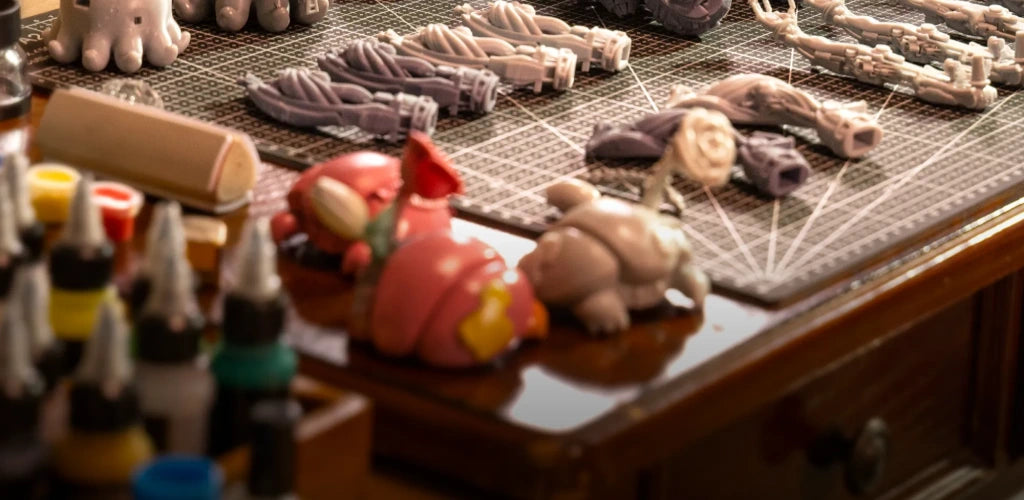STL files are one of the most common formats in 3D printing. Whether it is designing prototypes or custom parts, most printers, such as resin 3d printers, support STL files.
Before printing, we often need to modify, repair, or optimize these model files.
This article sorts out 10 good free STL file editors and briefly analyzes their functions to help you choose the tool that suits your needs.
Top 10 Free STL File Editors
1. Blender
Blender is a powerful open-source 3D creation software widely used in animation, modeling, rendering, sculpting, and video editing.
Although it has powerful tools that can easily modify and optimize 3D printing models, beginners may find the interface complex, making it difficult to operate.
Although Blender is great for creative projects, it may lack the precision required for technical modeling in the engineering or manufacturing fields.
2. Blueprint
HeyGears Blueprint is a 3D printing pre-processing tool for high-quality models, offering automatic repair, layout, support generation, and slicing in around 10 minutes with a 98% success rate.
It minimizes manual work, is beginner-friendly within 60 minutes, and meets the needs of medical models, dental models, and custom manufacturing models.

3. Meshmixer
Meshmixer is a lightweight editor primarily used for repairing scanned models, adding support structures, and performing local sculpting.
Its intuitive operation makes it ideal for users who need to process STL files, especially for print preparation quickly.
However, its features are somewhat basic, making it less suitable for handling complex modeling tasks. It is best used for simple model repairs and modifications.
4. Tinkercad
Tinkercad is an online modeling tool aimed at beginners, ideal for educational purposes. It supports basic geometric combinations and exporting STL files, with a simple, user-friendly interface that requires no installation.
While it is convenient and easy to use, its functionality is limited, making it unsuitable for handling complex or intricate designs.

5. OpenSCAD
OpenSCAD is a programming-driven 3D editor suitable for users who prefer precise modeling through code. Unlike graphic interface tools, it relies on programming for modeling, making it efficient for creating repetitive or parametric models.
However, due to its programming-based approach, it may not be intuitive for non-programming users and has a steeper learning curve.
6. Fusion 360
Fusion 360 is a comprehensive CAD tool that offers a free personal use license, integrating modeling, simulation, and mechanical design features.
Its STL editing capabilities are also quite strong, making it suitable for both beginners and hobbyists. However, its learning curve can be steep for more complex designs, and it may experience performance issues on low-spec devices.
7. 3D Builder
Developed by Microsoft, 3D Builder is a lightweight choice for Windows users, providing basic STL editing and repair functions.
With a simple interface, it is ideal for handling simple models or making quick modifications. However, its limitations become evident when dealing with more complex designs or repairs.

8. Wings 3D
Wings 3D is an open-source polygon modeling tool that, while not specifically focused on STL files, supports importing and exporting STL formats. Its flexible modeling tools are user-friendly for intermediate users and suitable for polygon modeling.
However, it lacks more advanced features and a complex user interface, making it less ideal for professional users with high demands.
9. FreeCAD
FreeCAD is an open-source CAD software aimed at mechanical engineering and product design, supporting parametric modeling and STL file imports, making it suitable for users who need precise control over dimensions.
Its modular design also allows users to extend functionality as needed. However, due to its vast feature set and more complex interface, it can be challenging for beginners to get started.
10. Lychee Slicer
Lychee Slicer is a slicing software designed for resin 3D printers, aiming to provide an efficient operating experience and help users quickly prepare and optimize STL files.
Whether you are a beginner or an experienced user, Lychee Slicer can provide you with a complete set of tools to simplify the preparation work before printing.
How to Choose the Right STL Editor?

1. Types of Editors
-
Graphical Tools: Tools like Blender and Tinkercad are best for freeform modeling.
-
Repair Tools: Software like Meshmixer and 3D Builder is ideal for model preparation before printing.
-
Parametric Tools: OpenSCAD is perfect for precision work and batch processing.
2. Experience Level
-
Beginners: Tinkercad and 3D Builder are easy to use with simple interfaces, making them great for newcomers.
-
Intermediate Users: Meshmixer and Fusion 360 offer more robust features for model repair and structure adjustments.
-
Professionals: HeyGears Blueprint and FreeCAD are tailored for advanced users who need smart repair and batch processing features.
3. Specific Needs
-
Model Creation: For building models from scratch, Blender and Fusion 360 provide powerful tools.
-
Print Preparation: If you’re focusing on model repairs and optimizations, HeyGears Blueprint and Meshmixer are excellent choices.
-
Batch Processing: For working with multiple models, Blueprint’s automatic support generation and layout tools improve workflow efficiency.
-
Parametric Modeling: OpenSCAD is ideal for projects that require precise, repeatable model generation.
4. System Requirements
-
Low-Spec Devices: Tinkercad (browser-based), 3D Builder, and Meshmixer run smoothly with minimal hardware requirements.
-
High-Spec Devices: Blender, Fusion 360, and FreeCAD require more powerful hardware for optimal performance.
Why STL File Format Popular?
STL files are favored because of their simplicity, versatility, and wide support across 3D printers.
They describe the surface of a model using triangular patches, making it easy for printing software to interpret. While they don’t support advanced features like color or texture, they are sufficient for most 3D printing tasks.
Conclusion
Choosing the right STL editor, along with the appropriate resin, can greatly improve your workflow efficiency and print quality.
Whether you're a beginner or an experienced modeler, understanding your needs and selecting the right tools will help you achieve better results in your 3D printing projects.
FAQ
Where can I find free STL files for resin printing?
You can find free STL files for resin printing on platforms like Thingiverse, MyMiniFactory, Cults3D, and Printables. These websites offer thousands of models optimized for resin printers, including miniatures, jewelry, and prototypes.
Where can I download free STL files for 3D printing miniatures?
Many websites such as Thingiverse, Yeggi, and Cults3D, provide free STL files for miniatures. Search using tags like “miniature,” “figurine,” or “tabletop model” to find downloadable designs ready for printing quickly.
What are the best websites to find free STL files?
Some of the best free STL websites include Thingiverse, or some Top Alternatives Websites for Thingiverse like Printables, MyMiniFactory, Thangs, and Cults3D. They feature a wide range of models for FDM and resin 3D printers, covering categories like art, tools, gadgets, and miniatures.
What is Thingiverse, and how do I use its STL files?
Thingiverse is one of the largest online libraries of free STL files for 3D printing. To use it, simply browse or search for a design, click “Download All Files”, and then import the STL file into your slicer software (such as Chitubox or Lychee) before printing.
How can I create my own STL files for 3D printing?
You can create your own STL files using 3D modelling software such as Blender, Tinkercad, Fusion 360, or ZBrush. After designing your model, export it in .stl format, which can then be sliced and printed on your 3D printer.
Related articles:



Share:
How to Make Money 3D Printing in 2025
Top Alternatives Websites for Thingiverse